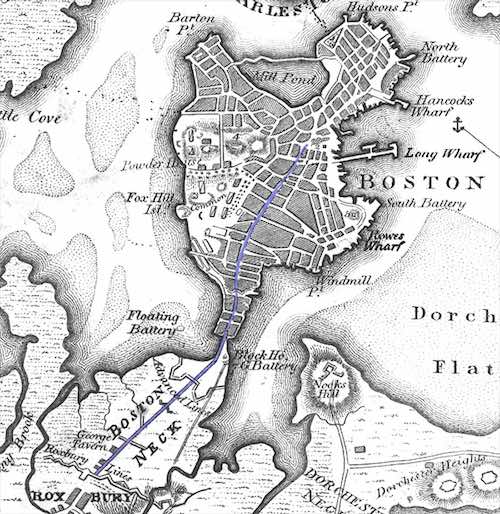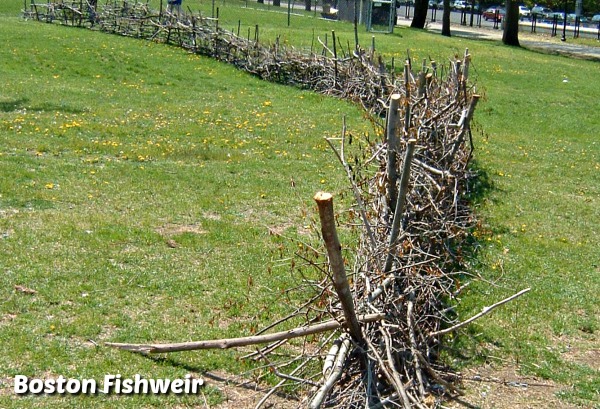Boylston Street Fishweir
Long before the English had settled in Boston, the Indians were fishing off Boston Commons.
About 3,000 years ago the area known as the Boston Commons was waterfront property.

Boston in the Early Days.
Fishweir
Indians use to fish right around the Boston Commons and much of Back Bay. They would build Fishweirs to trap fish as they swam with the tides.
A fishweir is a dam or "fence" on stakes set in a stream or waterway to trap fish.
First Major Site - Boylston Street station (1913)
Fishweirs were first discovered in 1913 during the construction of the Boylston street subway system. Construction workers didn't know what they encountered and inadvertently destroyed many valuable stakes. Some were saved and were discovered to be about 2,000 years old.
This fishweir location is commonly called the "Boylston Street Fishweir."
Second Major Site - New England Mutual Life Insurance Company (1939)
Fishweirs were also discovered at 500 Boylston Street in August 1939, when setting up the foundation for the New England Mutual Life Insurance Company. Scientists have calculated that they go back to 1700 B.C.
Hand-sharpened stakes, roughly about 5 feet in length and about an inch in diameter were found in the clay. The Robert S. Peabody Foundation discovered 65,000 stakes in the two-acres location.
The Archaeology of Philips Academy in Andover, Mass discovered that there were seventeen different types of wood use. Including Sassafras and Sycamore. Scientists were able to figure out that the wood was cut between the middle of April and the middle of June.
Third Major Site - John Hancock Building (1946)
During construction of the tower, several vertical wood stakes were discovered. Scientists were able to slowly map out a pattern of how the fishweirs might have been used. The weirs were built to trap certain type of spawning fish in shallow water tidal areas.
Some experts say that the Back Bay is loaded with ancient Fishweirs buried deep - many at least 3000 years old. The clay has helped preserve the wood that was used. Scientists have been studying the wood to learn about the fishing habits of Indians.
Every time a new building is constructed, a team of experts checks out the soil for any signs of Fishweir.
17th Century Factoid
While the Indian's were capturing fish, in what would be the future location of the city of Boston, the last Wooly Mammoth we still walking around in Russia.
Arlington Street T Station
There is an artwork panel at the platform level. The diorama panel explains how the ancient Boylston Street Fishweir worked. You can learn a little bit of local history while waiting for the next train.
Location the original Wooden Stakes
According to my research the original wooden stakes found in the 1913, 1939 and 1946 sites are kept in the The Robert S. Peabody Museum of Archaeology. They are kept out of public viewing.

Ancient Fishweir Project
Every spring students at the Boston public school take a field trip to the Boston Commons and spend a day building a replica of the Fishweirs in the Boston Commons.
Students learn about the Fishweirs and some of the cultures from Wampanoag Nation Singers and Dancers. Some Information about the annual event:The Ancient Fishweir Project combines public art, educational programs, and community events in celebration of the contemporary Native American community.
3,700 to 5,300 years ago, near what is now Boston Common, Fishweirs were built along the tidal flats to catch fish during the spring spawn.
The Fishweir Project's annual building of a Fishweirs on Boston Common brings this ancient activity into the current imagination, expanding the time frame of history told in Boston, and honoring the people who lived in the place we now call Boston.
Learn more about the fishweir at the TEDcBeaconStreet Ted Talk.
Viewing the Fishweirs
The final results of the kid's work are on display at the Charles Street entrance to the Boston Commons. (Near the Baseball Field)
